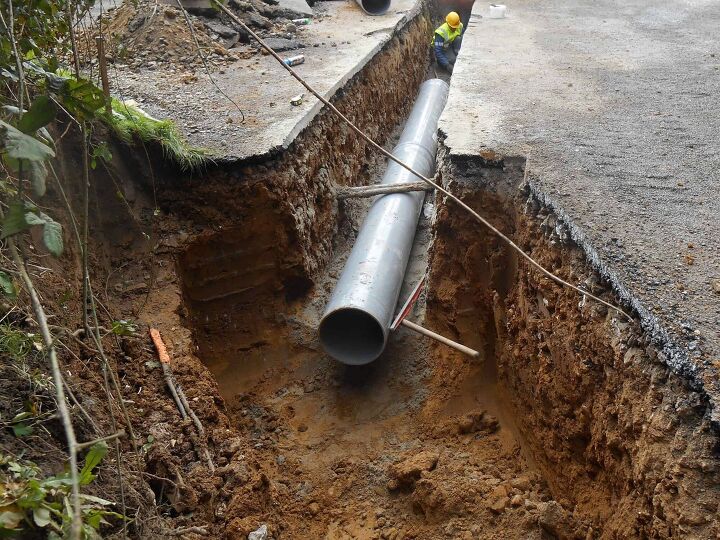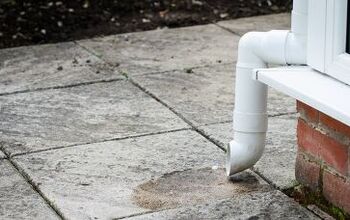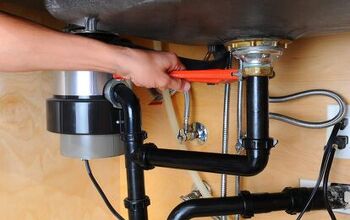How to Slope a PVC Drain Pipe

A sloped drainpipe is essential for your plumbing to work correctly. If your drainpipe is not sloped, it can cause a slew of issues. You may find yourself in a position where you must slope it yourself. Therefore, you need to understand the steps to do this project successfully.
Measure your waste line and slope your PVC pipes at ¼” per foot going from beginning to the end of your drain pipe. Multiply the slope per foot by the length of the waste line to determine your slope. Water will back up into the sink and the drain may clog if you install PVC pipes with the wrong slope.
In this article, we will describe the steps you need to take to slope your PVC drainpipe. Also, we will explain the general measurements and how to calculate your slope.
Do You Need to Hire a Plumber?
Get free, zero-commitment quotes from pro contractors near you.

The Importance of Drainage Pipe Slope
The proper slope of gravity drainage and sewer pipes is crucial to the functionality of your plumbing fixtures. It allows liquids to flow smoothly, helping to transport solids away without any risk of clogging.
If pipes are installed too flat, waste cannot flow properly. Additionally, if pipes are installed at a slope that is too steep, it is commonly understood that liquid will flow too quickly, also causing solids to not be carried away.
How to Slope a PVC Drain Pipe
With that said, it’s important that you understand all the steps to ensure that you have a properly sloped drain pipe. Follow the steps outlined below to plan and calculate the proper slope needed based on the length of your specific drain.
Step One: Accurately Measure Your Waste Line
Before you do anything, you need to know how far the drain line is going to travel. This is an essential part of the formula for calculating your slope. If you have curves and bends in your waste line, be sure to measure these too and label them accordingly. If you choose the same route, you will need to calculate each slope individually.
Step Two: Plan Your Draining Route
Remember when you’re planning the drain route that you want to keep it as short as possible. Longer draining routes have higher chances of clogging.
If you find that you have an excessively long waste line, try to reroute your pipes. Sometimes this will consist of corners, bends, and 90-degree angles. It’s best to have these bends further down the line. This will allow the waste to gain momentum and will decrease the chance of clogs.
Step Three: Determine the Drain Length
Now it’s time to get the PVC and to put your plans into action. After you know the waste line’s route and length, you can purchase the PVC pipes. Make sure that you have written down the size of the bends and angles as well.
While you’re here, purchase all the components you need to need to complete your project. This includes:
- Elbows
- 90-degree angles
- Straight PVC pipes
- Tools you may need to get the job done.
Once you have all the necessary tools, you are then ready to calculate your slope.
Step Four: Calculating Your Slope
Your slope should be calculated at ¼” per foot for a diameter that is 1 1/2″ is smaller. The slope is the measurement from the beginning to the end of your drain route.
Slope Calculations for a Diameter 2 1/2″ or Smaller | |||||||
1/4″ Per Foot | |||||||
Drain Length | 10 ft. | 13 ft. | 15 ft. | 18 ft. | 20 ft | 25 ft | 30 ft |
Correct Slope | 2.5″ | 3.25″ | 3.75″ | 4.5″ | 5″ | 6.25″ | 7.5″ |
Now, in the case that you don’t have a lot of room to work with, you will PVC drainpipes with a larger diameter. People usually choose the 3-6 inch diameter pipes.
Slope Calculations for a Diameter 3 – 6 inches | |||||||
1/8″ Per Foot | |||||||
Drain Length | 10 ft. | 13 ft. | 15 ft. | 18 ft. | 20 ft | 25 ft | 30 ft |
Correct Slope | 1.25″ | 1.625″ | 1.875″ | 2.25″ | 2.5″ | 3.125 | 3.75″ |
To get the proper slope, you multiply your slope per foot with the total length of your waste line. If the diameter of your PVC drainpipe is larger than 10″ then you will need to measure 1/16″ per foot.
Use the Charts for Comparison
Your waste line probably won’t measure out to a whole number, for example, 10 feet or 20 feet. It may be 10 feet and 7 inches. These charts are for comparison, and to get a baseline idea of the correct way to calculate your slope.
Besides, these charts will be handy for when you’re measuring. That way, you know you’re at least in the general vicinity of where you should be with calculations.
Slope Measurements for PVC | |
Diameter | Inches |
2 1/2″ or Smaller | 1/4″ per foot |
3″ to 6″ | 1/8″ per foot |
10″ or Larger | 1/16″ per foot |
Signs That Your Slope is Not Steep Enough
If you install your drain wrong, several telltale signs let you know you may need a steeper slope:
- Slow drainage
- Sewage backing up
- Water backing up into the sink
- Frequent Clogging
Some people mistake these signs as something else and pay hundreds of dollars for a professional to diagnose. Most often, though, it is a sign that you need a steeper slope. To do this, simply take your drain line apart and redo it.
Yes, it’s an incredibly involved process; however, if you’re a DIY enthusiast like us, then it won’t be too tricky! As long as you take your time and measure properly, you should have no issues.
Signs That Your Slope is Too Steep
Just as your slope may not be steep enough, it can also be too steep. Slopes that are too steep will present with a variety of unwanted problems.
Signs of a slope that is too steep includes:
- Persistent clogging
- Plumbing leakage
- Eventually, you will need to replace the pipes again.
If your drainpipe is too steep, the water will flush faster than the waste. When this happens, the debris will build up and clog the drain. Rather than spending hundreds of dollars on Drano, it’s best just to redo your waste line.
Plumbing Codes
Plumbing codes require you have a minimum of ¼” per foot for PVC pipes with a smaller diameter when calculating your slope. The maximum allowed is 3″ per foot or vertical. This is only in extreme cases, which for PVC you will be increasing the diameter of your pipe and most likely won’t need 3″ per foot.
Additional Tips for Success
There some other tips for you to successfully get this job done:
- Calculate how steep you need your slope before beginning installation
- Make sure you comply with plumbing codes.
- If you have 90-degree angles or bends in your drainpipe, slope each of those individually.
- Research the best way to access your waste line to bypass any unnecessary work or costs.
What Are PVC Pipes?
Depending on the age of your home, you may have drain pipes that are common in recent construction or the pipes that are typical of buildings built during the previous century. In most homes today, you’ll find pipes made of either copper, acrylonitrile butadiene styrene (ABS) or polyvinyl chloride (PVC).
Over the last four decades, PVC has been the leading choice for residential drain lines. It is a highly-durable, light-colored plastic material that is resistant to the elements. PVC has also been proven to outlast virtually every other piping material. It is made in a variety of grades including: schedules 40 and 80 and chlorinated polyvinyl chloride (CPVC).
- Schedule 40 is typically used for the drain-line pipes underneath homes.
- Schedule 80 is most often used in certain cold-water lines. However, it is controversial due to its inability to withstand hot water.
- CPVC is able to handle heat and is used in various parts of the United States for interior piping purposes.
Related Questions
How Do You Calculate the Slope of a Pipe?
To calculate the slope of a pipe, you need to divide the vertical fall by the length. Both the fall and the length need to be in the same units, though.For example, if the pipe’s fall was 2 feet and the pipe was 75 feet long, you would divide two by 75.
Which Pipe is Best for Underground Drainage?
The best pipe for underground drainage is PVC or Polyvinyl Chloride. This is because of the smooth wall inside of a PVC. The smooth wall allows waste to drain more efficiently. It also keeps the debris from sticking as much.
How Long Will PVC Pipes Last Underground?
PVC pipes last between 25 to 40 years underground. However, because of the recent advancements in technology, they now can last more than 70 years!The fact that PVC lasts so long is the reason that it’s an ideal type of piping for your drainage line. Complying with plumbing codes is an essential part of the job.
Do You Need to Hire a Plumber?
Get free, zero-commitment quotes from pro contractors near you.

Wrapping It Up
This project is not something that you can just rush through. It will take time, patience, and effort on your part. It can be frustrating to take on a large project. However, if you take the time to do it right, it spares you from unnecessary work.
Complying with plumbing codes is another essential part of the job, which can be tedious and frustrating at times. Although, doing a job like this yourself beats having to pay for a professional. The effort and time it takes to do the job are well worth the money that you will save!

Heather is a passionate writer who loves anything DIY. Growing up, she learned everything from home repairs to design, and wants to share her tips with you. When she's not writing, she's usually hiking or searching for her next DIY project.
More by Heather Robbins














![10 Best Zero Turn Mowers – [2022 Reviews & Ultimate Buyer's Guide]](https://cdn-fastly.upgradedhome.com/media/2023/07/31/9070522/10-best-zero-turn-mowers-2022-reviews-ultimate-buyer-s-guide.jpg?size=350x220)












